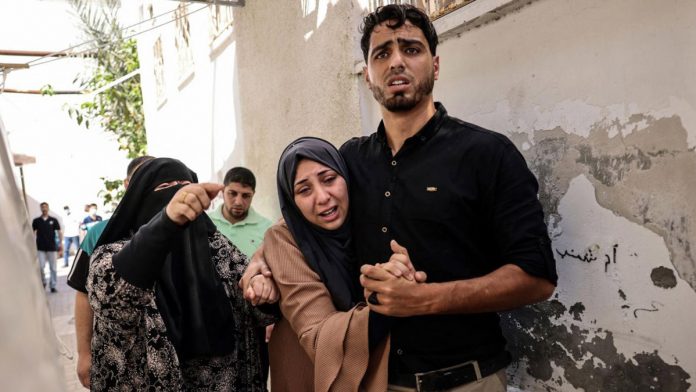The inhabitants of Sheikh Radwan, a district in the northern part of Gaza City, have long been familiar with the harsh realities of warfare.
Emad Jameel, a 31-year-old who grew up in the neighborhood, has witnessed the first and second intifadas and endured the challenges imposed by the blockade since Hamas took control of Gaza in 2007.
Despite facing repeated airstrikes during and outside wartime, Jameel had always found comfort in the support of friends and family.
However, the current conflict has brought unprecedented hardship, leaving him homeless and constantly seeking safety for his children across the besieged territory.
As of Wednesday, the local health ministry reported 21,000 casualties, with thousands feared trapped under rubble, and over 55,000 people injured, as Gaza continued to be pounded by heavy bombardment.
Jameel, a clothing shop assistant, expressed his anguish, questioning why his community endured such suffering and whether the world was indifferent to their plight.
His only wish is to return home, even if it lies in ruins, preferring a tent in his familiar surroundings over the uncertainty of unfamiliar places with strangers.
Two weeks into the latest conflict, triggered by an unprecedented attack by Hamas, Jameel, along with his wife and three children, could no longer endure the relentless Israeli airstrikes.
Following the Israel Defense Forces (IDF) evacuation order, they packed essentials and moved south of Gaza City for safety.
After a day of walking, they reached Madinat al-Zahra, where they stayed with distant relatives.
However, as Israeli troops initiated a ground operation encircling Gaza City, the family realized they needed to flee again.
Their next destination was the Bureij refugee camp, designated as an evacuation zone by the IDF, where they sought refuge in a crowded school along with hundreds of others.
In the following weeks, the camp faced shortages of clean water, food, and basic supplies, while intense fighting persisted.
Last week, Israeli soldiers, supported by airstrikes and artillery, entered Bureij and other central areas, resulting in some of the worst bloodshed in the 12-week-old war. The IDF instructed thousands in the camp to move again, this time to the nearby town of Deir al-Balah.
Now living in two tents provided by an aid organization, Jameel and his family endure the harsh winter conditions, uncertain of their future. Jameel is actively seeking a place for them in Rafah, near Gaza’s border with Egypt, before the inevitable need to relocate once more.
“Life is miserable in every sense of the word. We are unsure what to do or where to go. Our existence is marked by humiliation, standing in queues, and asking people for food and drink.”
Jameel’s family is not alone in their ordeal, as approximately 85% of Gaza’s 2.3 million people have been displaced, with many experiencing multiple displacements. The latest UN food security assessment estimates that 90% of Gaza is facing starvation.
Each day brings fresh horrors, with incidents like the return of bodies and verified videos depicting captive men, including children, held by Israeli soldiers.
Despite international pressure for Israel to scale back its operations, the violence persists, and ceasefire talks seem to have stalled. Israel’s military chief predicts a prolonged conflict, indicating that the war will endure for many more months.













